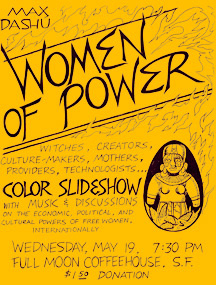
Full Moon coffeehouse, San Francisco, circa 1976
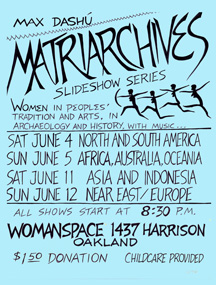
Series circa 1975 at Womanspace coffeehouse in Oakland CA
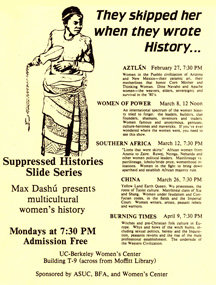
Series at University of California - Berkeley, 1984
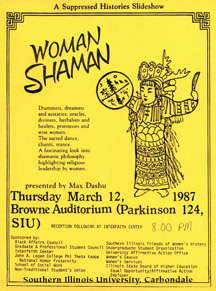 Southern Illinois University, Carbondale, 1987
Southern Illinois University, Carbondale, 1987
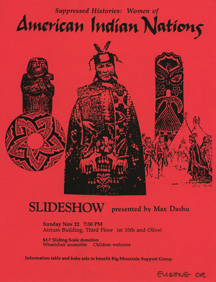 Women of American Indian Nations, Eugene OR circa 1981
Women of American Indian Nations, Eugene OR circa 1981
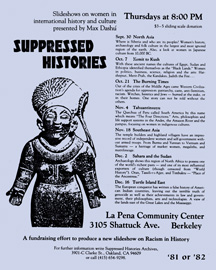
Series at La Peña Community Center, Berkeley CA circa 1981
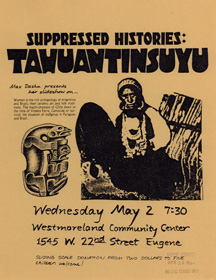 Show on South American women in Eugene OR, early 1980s
Show on South American women in Eugene OR, early 1980s
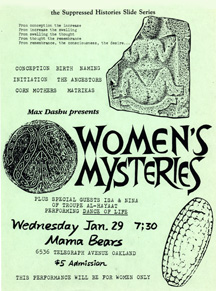
Mama Bears bookstore Oakland CA
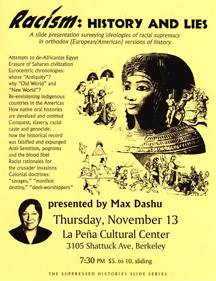
La Peña Cultural Center, Berkeley CA, circa 1986
the Suppressed Histories Archives
how it came about
by Max Dashú
For fifty years, I have been researching global women’s history and cultural studies. The Archives collection holds over 15,000 slides and another 20,000-plus digital images, as well as photocopies, text files, written notes, clippings, maps, books, exhibit banners and boards.
I created some 130 slide presentations, about a third of which are international surveys on topics such as Female Rebels and Mavericks, The European Conquests, and Prophetic Women. The rest of the shows look at women's history chronologically, by country or region. I have done hundreds of visual presentations for all kinds of audiences: feminist bookstores and women's centers, universities, elementary and high schools, libraries, community and senior centers, museums, prisons, youth groups, galleries, festivals, and conferences— and now via webcasts.In the fall of 1969, in the midst of the anti-war movement and the ascent of women’s liberation, I left behind a full scholarship at Harvard, that I had worked hard for throughout high school. I wanted to do research on global women’s history, mother-right, patriarchy, and the origins of domination. Women’s Studies did not yet exist, women's history was literally treated as a joke, and the climate in most of academia was hostile to raising questions about women’s status and how female freedom and power were systemically repressed. So I undertook to do this as an independent scholar,I began to scour libraries for evidence of women’s leadership and other social patterns that fell outside the claimed universality of male domination.
I focused on the missing center of women from a global perspective, seeking to understand how domination worked in terms of sex, class, racialized caste / ethnicity. I intuited that the broadest and deepest
expressions of female leadership would be retained in the Indigenous world, among the same cultures that had been disparaged and disregarded—the ones we were never taught about, that were not kingdoms or empires —and this thesis proved out.
I soon found that women's leadership commonly crosses the boundaries of political, religious, economic, and artistic spheres as laid down in the classic “Western Civ” worldview. This pattern was one of many pointers toward a different cultural paradigm. And it is the oral histories of the aboriginal peoples, and other cultural traditions, that substantiate these suppressed histories, fleshing out women's contributions and spheres of power.My research in archaeology showed that neolithic iconography overwhelmingly emphasized
women, in a qualitatively different way than modern media. I found that women in Indigenous societies had more freedom and authority than women in feudal and colonial systems, and that all present-day matrilineages occur in Indigenous societies. Abundant indicators showed that male domination of women correlated with domination by class, ethnicity, and other socio-political hierarchies.
Historical patterns emerged in which upper classes were more invested in patrilineage, multiple wives, and in constraining women’s bodies and behavior, than commoners or indigenous peoples were. That is why the Romans called the ruling classes "patricians" ("those of the fathers") as against the plebeians ("commoners," who Cato said "know not their fathers"). It is why veiling and female seclusion began with elites in Indo-European and Semitic societies; and why footbinding and corsets arose among aristocrats, before these constraints spread to women in other classes and cultures, often through conquest.
I found that public female spheres of power tended to concentrate in areas of spiritual leadership and, conversely, that banning the priestess was a way to deepen the cultural colonization of women. A more profound level of domination was possible through religious doctrine than could be achieved through violence and coercion, if only women could be induced to believe that their oppression was divinely ordained and to acquiesce to an idolatry of the masculine —and to all-male religious authorities.Witch persecutions remain a common pattern of attack against female power, solidarity, protest and resistance. Persecution of medicine people was a crucial tactic that colonizers used to break the spirit of countries they were invading. This repression went hand in hand with forced conversions and outlawing indigenous religion, or spiritual culture of subordinated classes and peoples. Women shamans, diviners, and medicine women have often been at the forefront of liberation movements. (See “Priestesses and Political Power” and Rebel Shamans )
In 1973 I acted as historical consultant for Donna Deitch, who was working on one of the first feminist documentaries, Woman to Woman at UCLA film school. She gave me the opportunity to collect images from university libraries in southern California, and in the process I learned copy photography. I came away with an initial collection of about 320 slides, which were the seedlings of the Suppressed Histories Archives. This serendipitous connection, made through Judy Grahn, was what turned me in the direction of using images to teach.
I got a camera and began to photograph more images. I put together slideshows and presented them at women’s bookstores, centers, coffeehouses. The first showing, Matriarchives, took place in 1974 at A Woman’s Place bookstore in Oakland, California, backed by live music by Sandy Ajida, Kay Sato, and Cindy Fitzpatrick. The Women of Power presentation premiered at Full Moon Coffeehouse in San Francisco in 1975, and was also shown at Mountain Moving Café in Portland and Mother-Right bookstore in Santa Cruz.
In 1976 this growing women’s history collection took the name of The Suppressed Histories Archives. I never intended to start an archive, but it grew anyway, in a passion to document what had been cloaked, omitted and distorted for so long. Year by year by decade, I kept adding thousands of new slides to the Archives, along with new articles, notes, and graphics. I dragged home loads of books on the bus, read and photographed archaeological and historical images from them, ran slide film in to develop, stripped and labeled the slides, and then repeated the process over and over.Over the following decades, I continued to archive historic images of
women. I researched mother-right cultures, priestesses, female shamans, witches and the witch hunts, goddess veneration, Indigenous philosophies of spirit, female elders and chieftains; patterns of conquest and colonization, the role of captivity and slavery and class systems in the development of patriarchy, and the uses of religion in intensifying male domination. I looked at patterns of racist and sexist bias in the way the archaeological and historical record had been evaluated. I called attention to disregarded cultural riches in the Sahara, Ecuador, Sumatra, Indiana, Nubia, Siberia, Utah, Ireland, Ethopia, and Portugal.
I began doing guest lectures at universities in 1981, while continuing to teach through grassroots venues: community centers, women’s conferences and festivals, public schools and libraries, and the occasional prison, gallery, and museum. I presented primarily at college women’s centers, including at Northwestern, Stanford, Princeton, UC-Berkeley, University of Wisconsin, and many other universities around the US. All this time I worked as a housepainter, cleaner, eldercare attendant, whatever jobs I could contract that were flexible enough to let me travel occasionally to colleges around the US to give talks. It was a balancing act, and not a lucrative one, but the priority was to spend as much time as possible on doing the research.
The Suppressed Histories Archives website went online in 2000, reaching out to an expanded audience with
tens of thousands of readers from every country. It features dozens of articles, book excerpts, interviews, and image galleries. Some articles have been translated into Dutch, French, Italian, and Hungarian on other websites. Others are available in Spanish on the SHA site, and we plan to add many more. I follow dozens of scholarly listservs, correspond with scholars in other countries, and occasionally field queries from researchers (though that has gotten too time-consuming).
In 2001 I published a critique of Cynthia Eller’s The Myth of Matriarchal Prehistory that has been read by thousands. It was reprinted in the British journal Feminist Thealogy (Sheffield Press, 2006). I was the first person to stand up and challenge Eller’s attacks on Goddess scholars at the Gender and Archaeology Conference in 2002.In 1978 I began writing The Secret History of the Witches, a reconstruction of pagan European tradition that focuses on women's spiritual leadership and survivals of goddess reverence, as well as on how patriarchal enforcements accumulated over time. It was to be a sourcebook (which turned into a series over time) that investigated What Happened in Europe: how the European witch hunts arose and what their cultural impact was on women's lives and status.
The first volume, Witches and Pagans: Women in European Folk Religion, 700-1100, was published by Veleda Press (2016). An Italian translation from Venexia Editrice followed in 2018. The second volume in the series, Pythias, Melissae and Pharmakides: Women in Hellenic Culture, is forthcoming in 2020.
The series is intended as a resource for the restoration of authentic cultural roots that predate hierarchical religions. We need this knowledge to uproot old cultural poisons that continue to sow violence and destruction. In the decades since I began writing this series, many significant cultural turnings have taken place: the resurgence of Goddess reverence and more ominously, patriarchal fundamentalisms, authoritarian states, and new Crusades, colonizations, and witch hunts.
In 2008 I produced a video Women’s Power in Global Perspective, and in 2013 Woman Shaman: the Ancients. More videos will be available via stream on demand in the near future. I won't list titles of the many visual presentations here, some of which are described in the Visual Talks link. The bulk of my work has been in the oral tradition, speaking women's history through images that have survived in the cultural record. Sometimes in small groups, or in conferences, festivals, classrooms. Most of it is not yet available in written form. The goal now is to make recorded versions streamable, as many as is feasable in free access, and others for a nominal fee.
I gave keynote addresses at Feminism in London (2015), the Pagan Studies Conference at Claremont University (2008), the New Jersey Coalition for Battered Women (Rutgers, 2005), California State University at Chico (2000), Association for Women and Mythology (2009), and Women's Voices for a Change (Swarthmore, 2013). I presented at international conferences in Rila, Bulgaria; Glastonbury, England; Hambacher Schloss, Germany and San Marcos, Texas. I gave slide talks in Spanish at the Museo de San Miguel de Allende, Centro de Justicia Global, and other venues. I presented at conferences of the National Women’s Studies Association, the American Academy of Religion, and the Association for Women and Mythology. Also at Trinity College - Dublin, the Frauenmuseum in Wiesbaden, Germany, the State Library of Queensland, Australia, and at la Casa Internazionale delle Donne in Rome, Italy.
Meanwhile, the Archives is in the process of digitizing the slide collection, and expanding the image galleries, articles, and videos on the website. I'm preparing to add a huge chunk of already existing content: 10,000 pages from the Suppressed Histories Archives Facebook page need to be edited, formatted, and tagged for searchability. (That FB page has attracted a large audience —over 170,000 at this writing — through the photo essays, links, and information that are posted daily.) One of the most pressing tasks is creating navigation pages to allow readers to explore the SHA site and to find what they are looking for.
My articles have received over 64,000 views on Academia.edu, on a page that ranks in the top 1% most-viewed pages. The top article is Etruscan Women and Social Structure which has had 11,000 views, followed by The Gnostic Goddess, Female Power, and the Fallen Sophia. (Both of these are advance views from volumes in the Secret History of the Witches series, as are many other articles on the site). The third most-read article is Atete, Goddess of the Oromo People in southern Ethiopia (with the bulk of 2700 views being Ethiopian readers). These pdfs will be free access on the Suppressed Histories site as soon as I get free time to design and upload pages for them.
You can see some of the visual talks on Youtube, open access, and more videos are now available for stream-on-demand through the Suppressed Histories Portal on Teachable. At this writing, the latter includes Wu, Nü Shen, and Xi Wang Mu: Spirit Women in China; Sacred Signs: Symbols and Cosmologies; Ancient Crete; and Rebel Shamans: Women Confront Empire.
Coming soon are videos on Healers, Curanderas and Medicine Women; Ancient Treasures of African Women; a series including Witches and Pagans; The Witch Hunts, and Modern Representations of the Witch; Persecutory Cultures, and lots more.